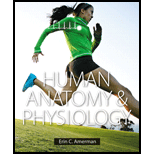
Human Anatomy & Physiology
1st Edition
ISBN: 9780805382952
Author: Erin C. Amerman
Publisher: PEARSON
expand_more
expand_more
format_list_bulleted
Question
Chapter 25.2, Problem 1QC
Summary Introduction
To review:
The definition of total body water.
Introduction:
The human body consists of about 60% water. This percentage of water is an indication of the volume of water that is present in the body of a standard man who lies in the age group of 20 to 30 years. In standard terms, a man consists of 42 kgs (kilograms) of water.
Expert Solution & Answer
Want to see the full answer?
Check out a sample textbook solution
Students have asked these similar questions
What are the three principal body fluids and the approximate percentage of total body water accounted for by each?
What is the effect of adding water to the body?
List the Body Fluid Compartments?
Chapter 25 Solutions
Human Anatomy & Physiology
Ch. 25.1 - 1. What is a body fluid?
Ch. 25.1 - 2. What is balance with respect to body fluids?
Ch. 25.1 - How does an electrolyte differ from a...Ch. 25.1 - What is electrolyte balance?Ch. 25.1 - 5. How do acids and bases differ?
Ch. 25.1 - 6. Which pH values are acidic, basic, and...Ch. 25.2 - Prob. 1QCCh. 25.2 - What factors affect total body water?Ch. 25.2 - 3. Where are the intracellular and extracellular...Ch. 25.2 - Prob. 4QC
Ch. 25.2 - Prob. 5QCCh. 25.2 - Prob. 6QCCh. 25.2 - Prob. 7QCCh. 25.2 - How is thirst stimulated?Ch. 25.2 - How are fluids lost from the body?Ch. 25.2 - 10. What are the water requirements for an...Ch. 25.2 - 11. What is the role of ADH in fluid balance?
Ch. 25.2 - How is ADH secretion stimulated?Ch. 25.2 - How does dehydration affect the volume of the...Ch. 25.2 - Prob. 14QCCh. 25.2 - 15. How do dehydration and overhydration differ...Ch. 25.3 - What are the main roles of sodium ions in the...Ch. 25.3 - How is sodium ion concentration regulated?Ch. 25.3 - Prob. 3QCCh. 25.3 - Prob. 4QCCh. 25.3 - 5. How is the concentration of potassium ions in...Ch. 25.3 - 6. What happens to the resting membrane potential...Ch. 25.3 - Prob. 7QCCh. 25.3 - Prob. 8QCCh. 25.3 - Prob. 9QCCh. 25.3 - Prob. 10QCCh. 25.3 - 11. How is chloride ion reabsorption in the...Ch. 25.3 - 12. How is the concentration of magnesium ions in...Ch. 25.4 - What are the major sources of acids for the body?Ch. 25.4 - Prob. 2QCCh. 25.4 - Prob. 3QCCh. 25.4 - Prob. 4QCCh. 25.4 - Prob. 5QCCh. 25.4 - Prob. 6QCCh. 25.4 - Prob. 7QCCh. 25.4 - Prob. 8QCCh. 25.4 - How do metabolic acidosis and respiratory acidosis...Ch. 25.4 - Prob. 10QCCh. 25.4 - Prob. 11QCCh. 25.5 - Prob. 1QCCh. 25.5 - Prob. 2QCCh. 25 - Prob. 1CYRCh. 25 - 2. How does an electrolyte differ from a...Ch. 25 - Prob. 3CYRCh. 25 - Prob. 4CYRCh. 25 - Prob. 5CYRCh. 25 - Prob. 6CYRCh. 25 - Which of the following is false with respect to...Ch. 25 - Prob. 8CYRCh. 25 - Prob. 9CYRCh. 25 - Prob. 10CYRCh. 25 - Prob. 11CYRCh. 25 - Prob. 12CYRCh. 25 - Prob. 13CYRCh. 25 - Prob. 14CYRCh. 25 - 15. Which of the following mechanisms is/are used...Ch. 25 - Mark the following statements as true or false. If...Ch. 25 - Prob. 17CYRCh. 25 - 18. How does angiotensin-II help to restore fluid...Ch. 25 - Prob. 1CYUCh. 25 - Prob. 2CYUCh. 25 - Prob. 3CYUCh. 25 - Prob. 4CYUCh. 25 - Prob. 1AYKACh. 25 - Prob. 2AYKACh. 25 - Prob. 3AYKACh. 25 - Prob. 4AYKACh. 25 - Prob. 5AYKB
Knowledge Booster
Similar questions
arrow_back_ios
SEE MORE QUESTIONS
arrow_forward_ios
Recommended textbooks for you
 Human Physiology: From Cells to Systems (MindTap ...BiologyISBN:9781285866932Author:Lauralee SherwoodPublisher:Cengage Learning
Human Physiology: From Cells to Systems (MindTap ...BiologyISBN:9781285866932Author:Lauralee SherwoodPublisher:Cengage Learning


Human Physiology: From Cells to Systems (MindTap ...
Biology
ISBN:9781285866932
Author:Lauralee Sherwood
Publisher:Cengage Learning